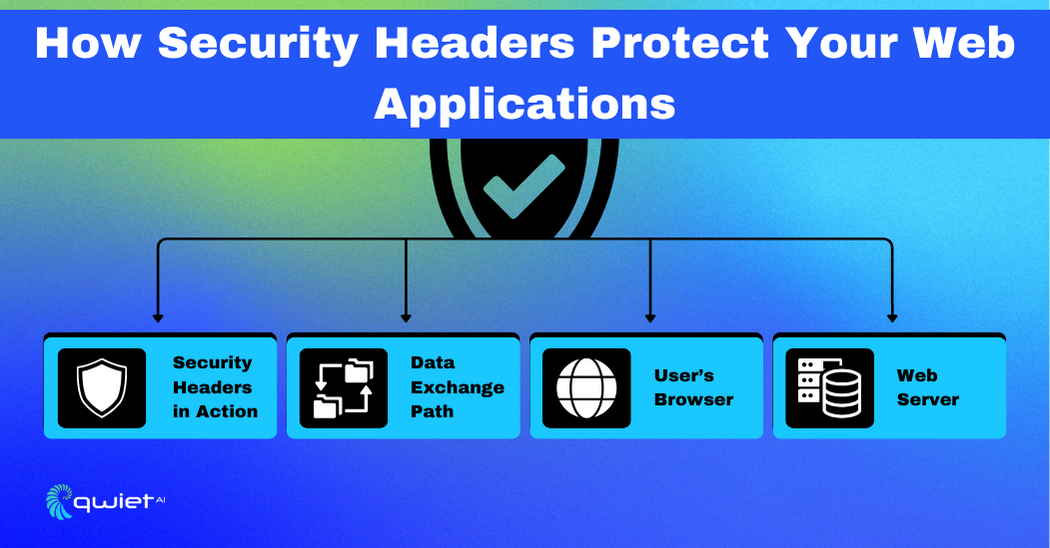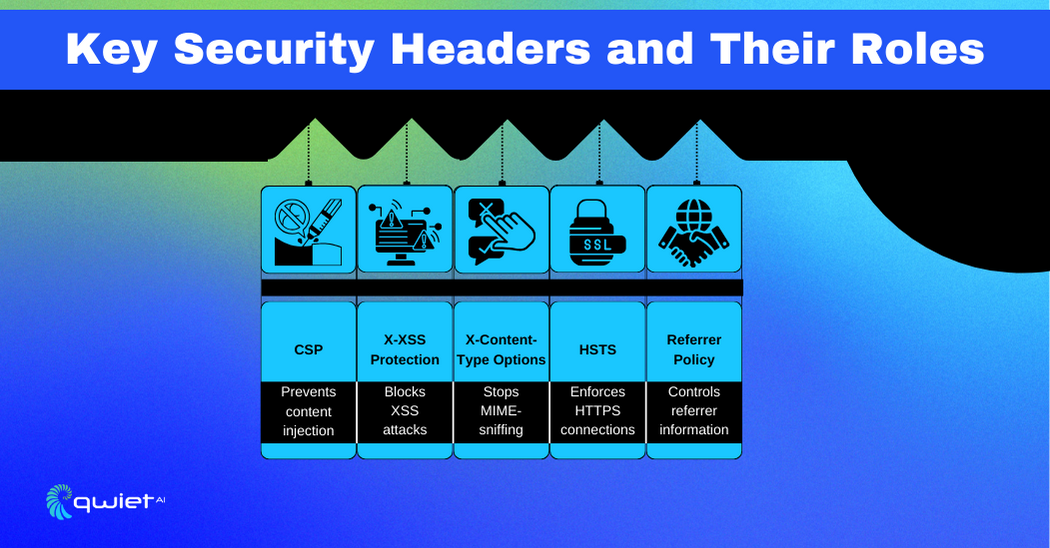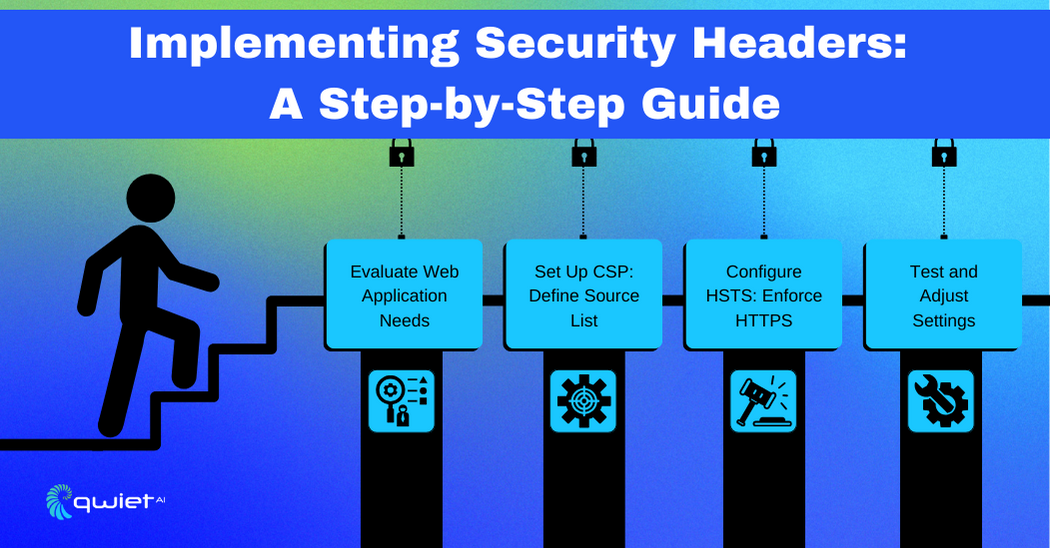What are Security Headers?
Security headers are tools web servers use to protect web applications by dictating how browsers should behave when handling a website’s content. These headers enhance security by preventing common vulnerabilities like cross-site scripting (XSS), clickjacking, and other code injection attacks. By specifying certain policies directly in the HTTP response headers, web applications instruct the browser on safe handling procedures, thereby preemptively mitigating potential threats.
How Security Headers Protect Your Web Applications

Security Headers in Action
Security headers are implemented by web servers to enforce specific security policies in users’ browsers. They actively protect the web application by controlling how resources are handled and interacted with.
| Content-Security-Policy: script-src ‘self’ https://apis.example.com; |
This directive of the Content Security Policy (CSP) restricts the execution of scripts to those hosted on the same origin as the document itself and scripts loaded from https://apis.example.com. This limits opportunities for XSS attacks by specifying trusted sources and excluding all others.
Data Exchange Path
This aspect involves the secure transmission of data between the user’s browser and the web server, utilizing headers that ensure all data exchanges occur over secure channels, protecting the integrity and confidentiality of the transmitted data.
| Strict-Transport-Security: max-age=31536000; includeSubDomains; preload |
HTTP Strict Transport Security (HSTS) forces the browser to use HTTPS for all communications with the web server, preventing SSL stripping and man-in-the-middle attacks. The max-age parameter specifies how long the browser should remember this policy, and includeSubDomains extends it to all subdomains.
User’s Browser
Security headers directly influence browser behavior, restricting actions that can compromise user security, such as preventing the content from being displayed in potentially malicious frames or iframes.
| X-Frame–Options: DENY |
This header prevents the webpage from being displayed in a frame or iframe, which is crucial for protecting against clickjacking attacks. The DENY directive ensures that no domain can embed the current page within an iframe, thus safeguarding user interactions on the site.
Web Server
In this context, security headers provided by the web server prevent browsers from making assumptions about the content type, mitigating the risk of MIME type confusion and blocking malicious content from executing under incorrect file types.
| X-Content-Type–Options: nosniff |
This header stops the browser from MIME-sniffing a response’s content-type away from the one specified by the server. This precaution helps prevent attacks in which the browser incorrectly guesses the MIME type, potentially executing harmful scripts.
Types of Security Headers and Their Roles

Content Security Policy (CSP)
The Content Security Policy (CSP) is a powerful security header designed to mitigate the risk of content injection attacks. It allows web developers to specify the browser’s resources to load and execute. By defining a whitelist of trusted content sources, CSP prevents malicious scripts from being loaded if they originate from unauthorized sources.
| Content-Security-Policy: default-src ‘self’; img-src ‘self’ https://trustedsource.org; |
In the above example, the CSP is configured to restrict all sources for scripts, styles, and other resources to the exact origin as the document (self). It also allows images to be loaded from the website’s domain as well as from trustedsource.org. This setup helps prevent content injection such as XSS by restricting where resources can be loaded, thereby not allowing attackers to inject malicious content from external or untrusted sources.
X-XSS-Protection
The X-XSS-Protection header is designed to enable the cross-site scripting (XSS) filter built into most web browsers. This filter detects attempts to inject malicious scripts into web pages and blocks them.
| X-XSS-Protection: 1; mode=block |
This configuration enables the XSS filter (1) and instructs the browser to block the entire page from loading if an attack is detected (mode=block). This helps prevent some types of XSS attacks by having the browser stop the page’s loading when a potential attack script is found.
X-Content-Type-Options
The X-Content-Type-Options header prevents the browser from MIME-sniffing the content-type of a response. MIME-sniffing can lead to security vulnerabilities when browsers incorrectly guess the MIME type of a resource, leading to malicious scripts being executed.
| X-Content-Type–Options: nosniff |
The nosniff directive tells the browser to adhere to the declared strictly content-type in the HTTP headers. This prevents the browser from interpreting the content if the server has declared the content type incorrectly or ambiguously, thereby blocking an avenue for certain types of attacks, such as those involving script execution where MIME types are misinterpreted.
HTTP Strict Transport Security (HSTS)
HTTP Strict Transport Security (HSTS) enforces secure (HTTPS) connections to the server, helping to prevent man-in-the-middle attacks by ensuring that browsers only connect via HTTPS.
| Strict-Transport-Security: max-age=31536000; includeSubDomains |
This header tells the browser only to access the site using HTTPS for a year (max-age=31536000 seconds). The includeSubDomains directive extends this policy to all subdomains, ensuring comprehensive protection across the entire domain.
Referrer Policy
The Referrer-Policy header controls the amount of referral information sent along with requests, which can help protect user privacy and reduce the risk of leaking secure URLs.
| Referrer-Policy: no-referrer-when-downgrade |
This setting prevents the browser from sending the referrer header when navigating from HTTPS to HTTP sites, protecting potentially sensitive information from being exposed on less secure connections. This is crucial for maintaining user privacy and security as it prevents potential leakage of URLs that may contain sensitive query parameters.
Security Headers Best Practices

Implementing security headers effectively is crucial for enhancing the defense mechanisms of web applications against cyber threats. This structured approach ensures compliance with security standards and addresses specific vulnerabilities your application may face. By meticulously configuring each security header, developers can fortify their applications, reducing the risk of data breaches and other security incidents.
Evaluate Web Application Needs
The first step in securing a web application is thoroughly evaluating its specific security needs. This analysis should include understanding the data flow, identifying sensitive data interactions, and recognizing potential security gaps. It’s also important to review the existing security headers and their configurations to determine areas for improvement.
| # Analyzing security headers of a web application curl -I https://example.com | grep -i Strict-Transport-Security |
This command uses curl to make a HEAD request to example.com, which fetches HTTP headers from the server. The grep command filters the output to show the presence and configuration of the Strict-Transport-Security header. Analyzing these headers allows developers to identify which critical security headers are missing or need adjustment, thereby tailoring the security settings to match the specific requirements of the web application.
Set Up CSP: Define Source List
Configuring the Content Security Policy (CSP) accurately is essential for controlling the resources the browser is allowed to load. A well-defined CSP can significantly reduce the risk of content injection attacks, such as XSS.
| <!– Setting up a comprehensive CSP for an application –> Content-Security-Policy: default-src ‘none’; script-src ‘self’ https://cdn.example.com; connect-src ‘self’; img-src ‘self’ https://images.example.com; style-src ‘self’ ‘unsafe-inline’; |
This CSP configuration sets a stringent default policy (default-src ‘none’) that blocks all content loading unless explicitly allowed. Scripts are confined to the same origin and a trusted CDN, while AJAX requests (connect-src) and images are limited to specific approved sources. Despite its security risks, this example also demonstrates allowing inline styles, a common requirement. By tailoring the CSP this way, the application minimizes the risk of unauthorized script execution and data leakage.
Configure HSTS: Enforce HTTPS
Implementing HTTP Strict Transport Security (HSTS) correctly is crucial for enforcing secure connections and protecting against common attacks such as man-in-the-middle (MITM).
| <!– Robust HSTS policy –> Strict-Transport-Security: max-age=31536000; includeSubDomains; preload |
This HSTS policy instructs browsers to strictly enforce HTTPS connections for the domain and its subdomains for one year (max-age=31536000 seconds). The preload directive is included to request the domain be added to the browser’s preloaded HSTS list, which ensures HTTPS enforcement even on the first visit before any interaction with the site. This comprehensive approach is essential for securing all data transmissions and reducing the attack surface against MITM attacks.
Testing and Validating Security Headers

Testing and Validating Your Security Headers
Once security headers are implemented, rigorous testing and validation are critical to ensure they function correctly and provide the intended protection. This process helps identify and rectify misconfigurations and refine security measures to respond effectively to emerging threats.
Developers and security professionals should adopt a comprehensive approach to testing, combining automated tools with detailed manual reviews to cover all aspects of security header implementation.
Use Browser Developer Tools to Inspect Headers
Developers can utilize browser developer tools to directly inspect the HTTP headers sent by the web server during sessions. This method allows for real-time validation of headers like CSP, HSTS, and others. It is crucial to check that the headers are not only present but configured correctly according to the security policy of the web application.
For instance, verifying that the CSP directive does not allow unsafe sources or that HSTS headers have an adequate max-age to enforce HTTPS over a long period. These tools can also help detect issues like headers being overwritten or ignored due to conflicting rules or misconfigurations in server settings.
Leverage Online Testing Services
Online testing services offer a more automated approach to header validation. These platforms analyze website headers and generate reports highlighting strengths and potential vulnerabilities. The benefit of such services is their ability to simulate different environments and attack vectors to test headers under varied conditions.
They often provide benchmarks and best practices comparisons, guiding developers on further enhancing header security. Utilizing these tools ensures a broader assessment, as they are updated regularly to incorporate the latest security standards and threat data.
Review Security Reports and Logs
Continuous monitoring and reviewing of security logs and reports are essential for understanding the behavior of security headers over time. This ongoing review helps identify anomalies, such as unexpected changes in header configurations or repeated attempts to exploit potential vulnerabilities.
It is also an opportunity to assess the effectiveness of headers in blocking or mitigating security incidents. For example, analyzing logs for CSP violations can reveal attempts to inject malicious content, informing necessary adjustments to the policy. This practice not only aids in fine-tuning security settings but also in documenting compliance with security policies and regulations.
Iterate Based on Feedback and Testing Results
The dynamic nature of web technologies and cyber threats necessitates continuous iteration of security header configurations. Based on the insights gained from testing, feedback, and real-world application performance, developers should regularly update headers to close any new security gaps and optimize performance.
An iteration might involve tightening a loose CSP, extending HSTS max-age, or refining the Referrer Policy to better protect user data. The goal is to develop a cycle of improvement that keeps security measures against an evolving landscape of threats while ensuring they do not impede the functionality or performance of the web application.
Conclusion
We’ve highlighted the vital role of security headers like CSP, HSTS, X-Frame-Options, and X-Content-Type-Options in protecting web applications from common threats such as XSS and clickjacking. To enhance the security of your web applications and fortify your codebase against evolving threats, schedule a consultation with Qwiet today.
Read Next
No related posts.
About Qwiet AI
Qwiet AI empowers developers and AppSec teams to dramatically reduce risk by quickly finding and fixing the vulnerabilities most likely to reach their applications and ignoring reported vulnerabilities that pose little risk. Industry-leading accuracy allows developers to focus on security fixes that matter and improve code velocity while enabling AppSec engineers to shift security left.
A unified code security platform, Qwiet AI scans for attack context across custom code, APIs, OSS, containers, internal microservices, and first-party business logic by combining results of the company’s and Intelligent Software Composition Analysis (SCA). Using its unique graph database that combines code attributes and analyzes actual attack paths based on real application architecture, Qwiet AI then provides detailed guidance on risk remediation within existing development workflows and tooling. Teams that use Qwiet AI ship more secure code, faster. Backed by SYN Ventures, Bain Capital Ventures, Blackstone, Mayfield, Thomvest Ventures, and SineWave Ventures, Qwiet AI is based in Santa Clara, California. For information, visit: https://qwietdev.wpengine.com
